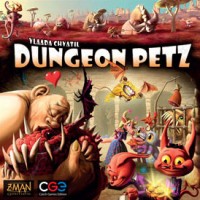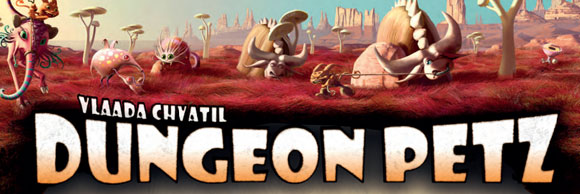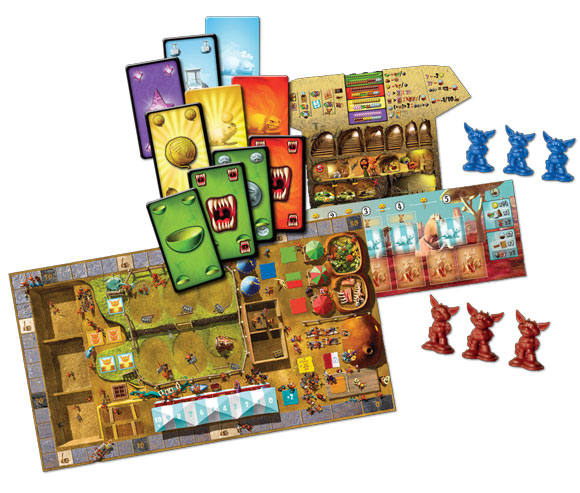
Dungeon Petz

In Dungeon Petz, you run a pet shop for dungeon lords. You start with your family of imps, some gold, and one dirty old cage.
The game consists of five or six rounds. In each round, you send your family members out to buy baby pets, cages for pets, food for pets, etc. Those imps who are not out shopping are busy caring for the pets, entertaining them, cleaning their cages, and watching them grow. Beginning with the second round, your pets will participate in local pet shows. The prizes you win will boost your reputation. In the third round, the local dungeon lords begin arriving, looking for pets. The more closely you match their tastes, the better your reputation will be.

Exhibitions and customers are revealed in advance, so you can plan for them – either by purchasing a suitable pet or by working to get the most from the pets you already have. However, these pets are living creatures. When they do something unpredictable, you will have to improvise.
At the end of the game, you get extra reputation for your economic success and your shop’s appearance. The player with the most reputation points wins.
User Reviews (5)
Add a Review for "Dungeon Petz"
You must be logged in to add a review.


Intro
Let me begin by saying that ‘euro’-type games are definitely my favorite, so bear that in mind. This text is not going to be a standard review, instead I will try to focus on my impressions of the game.
Dungeon Petz is at its heart a worker placement / resource management game with some secret auction parts. The aim of the game is to get the most VP by having the most successful pets collection by the end of the game. Your success is measured by your pet’s performance during contests and by how much your prospective customers like your pets.
Decisions
The game fetures several quite heavy decision making moments. The first one you stumble upon is the buying phase. This is the worker placement / secret auction part. To buy something (more cages, more pets, food, etc.) you need to send your goblins to specific spaces on the board. The problem is that the spaces are very scarce and the good ones run out fast. This is where the secret auction part comes in – you need to assign groups of goblins as your ‘buying groups’. The bigger the group, the sooner it comes on the board. The group assignment is secret, so you can’t be sure what your opponents do. You can for example build one large group to get something fast (thus making almost sure noone will beat you to it), but this means you won’t have goblins left to buy many other things or do some mop-up work later in the turn.
The next decision stage is needs management. Your pets have different (semi-random) needs. Each “point” of need means you have to draw a card in corresponding color and assign it to your pet. Generally each color contains various needs (such as eating, playing, etc.), but the composition of needs is different in each color. This means that you won’t know what needs exactly you will have to satisfy, but you can make some educated guesses. After assigning the needs you will have to satisfy them (resource management). You can choose not to satisfy a need, but this will earn you a suffering token, which lowers your score and may cause the pet to die.
After the needs phase, you will have the option to show your pets in contests and sell them subsequently. At this point, the needs you satisfied in the previous phase determine the features of your pets. The mechanic here is that each contest awards points for various features of your pets – for example a specific contest might award points for aggressive pets, while deducting points for playful pets. The selling mechanic works almost in the same way – some customers award points for specific features and deduct for others. Oh, you also know in advance what contest and what customer is coming the next turn – so you can prepare somewhat, though one turn is sometimes not enough.
The rest of the game is basically token and cube shuffling – nothing exciting. There is also the final scoring, but it is always the same.
Impressions
To sum up – I had some great fun playing this game and I can recommend it to anyone looking for midweight eurogames. Why did I like it?
1. Interaction – exactly the kind I like: indirect. You do compete for the same resources, but in no way mess with your opponents directly.
2. Randomness – quite big, but you also have quite a lot of tools to manage it. As a result no game is the same, yet you do not have the feeling of winning / loosing due to chance.
3. Snowball – no snowball! At one point I had like 20 points of advantage (40:20), but I had to miss one contest and did not manage to score too much during final scoring and the game ended with something like 68:66.
4. Quality – the components are superb (and also super cute :)). The mechanics are well thought out.
5. If I had to point out a flaw in Dungeon Petz, it has to be the manual – it is 20 pages long and some rules are quite convoluted. You will probably make several mistakes on your first playthrough. On the other hand – the manual is hilarious (pet descriptions rock) and you will learn the ropes quickly.
Vlaada Chvatil is back with another game to help those misunderstood dungeon lords protect their investments from those pesky adventurers. While Dungeon Petz takes place in the same world as the previously released Dungeon Lords, don’t feel that you need to have played Dungeon Lords to jump into, and enjoy, Dungeon Petz.
In Dungeon Petz, your imps have opened a pet selling business. Throughout the game, you’ll be sending out imps to get different items – using a worker placement mechanic – that are needed to raise pets. Outside of this phase, the main focus is raising your pets, which will have specific needs that need to be met each turn. Once those are dealt with (I discuss how that works below), all rounds but the first (there are six total) will have an exhibition that you can plan for. These exhibitions allow you to gain reputation points (this game’s name for VPs needed to win). Each exhibition will be scored based on the need cards you played on your pets, allowing you to (try to) plan ahead of time what type of needs your pet should have.
As you’re in the pet selling business, you will then have the option of selling your pets to customers. Each customer wants a certain type of pet and will give more points if they have certain need cards played on them, and fewer points for other types of cards. Customers are known a few rounds in advance, so you can attempt to plan for them.
In the end, there is a final scoring using the exhibition model, after which you can finally relax and think of how you’ll do things differently the next time you play.
Dungeon Petz is fairly involved, so I’ll spend a good amount of time talking through what you’ll be doing. If you’re primarily interested in my thoughts on the game, please jump past the following section).
Game Play
The game will play over 5 rounds (with a final scoring following). Each round has 6 phases. The rules for each phase aren’t overly difficult, but put together there are a lot of little rules. Once you know the rules, the iconography of the player aid that is part of your player board makes sense (but is very cryptic until you know those rules).
Phase 1 – Here you’re primarily setting up the board (making new item available), and getting income. New pets, cages, food, add-ons, and artifacts are put out for the round. You’ll also get 2 gold (1 if you’re the start player).
Phase 2 – Worker placement phase (shopping). Each player will secretly put their imps in groups (you start with 6). Each group can also include any amount of gold (but a group must have at least one imp). Once you reveal your groups, the player with the largest group (determined by the sum of imps + gold in a group) places that group first (ties broken by start player, and clockwise from them). The largest groups go first, taking the item they want once placed. This mechanic is a nice twist on worker placement, as you’re secretly “bidding” in hopes of getting the spaces you want. When it is your turn to place a group, you always have the choice to not send them out, holding them back for later.
Phase 3 – Assign the locations of cages, add-ons, and pets (you could potentially have up to four of each). This is the phase where you will assign need cards to your pets. Each pet will have on it icons representing how many cards they need, and what color they are. As pets age, they grow and require more cards. You draw cards of the appropriate colors as shown on each of your pets. These are added to your hand of cards that has one card of each of the four colors. Now, you’ll need to assign one need card of the correct color for each icon on the pet (in essence, you’ll be playing a number of cards equal to what you just drew). This is the main puzzle part of the game, and where a large amount of your time will be spent. The following rounds, as well as the continued health of your pet, will depend on how you play the cards.
Each card will have a need on it. The four colors each have a need that shows up on half of its cards, and the other half will have an assortment of needs (the player aid on your board shows the distribution). This means that if your animal has a lot of green cards, you’re most likely to have to feed it, but it’s not guaranteed that will be the cards you draw (red is most often anger, yellow is most often play, and purple is most often magic).
Phase 4 – Here you’ll address the need cards you just played on your pets, and enter the exhibition. Need cards are done in a particular order (again shown on the player aid). In general, if you have assigned a need but aren’t able to meet is (such as feeding, or playing), your animal receives a suffering token. Imps you held back in Phase 2 can be used to meet play needs. Additionally, you’ll compare the anger needs to the cage strength (red). If the anger is greater than the strength, you’ll have to assign held back imps to make up the difference (which go to the hospital) or the animal breaks out and runs away. Similarly, you’ll compare magic needs to the magic strength of the cage. If the magic needs are too great, your pet will mutate. If you ever have two mutation counters, the pet disappears. You’ll also have to deal with poop and sickness.
Once all of these needs are taken care of, you’ll enter the exhibition. The exhibition tile will have been seen ahead of time. Some are single pet, others are all pets. The exhibition will give positive points for certain needs, and negative points for needs/items (suffering, sickness, mutations, and poop may all be bad). The points you gain are compared to the opponents, and you’ll score reputation points based on your order of finish.
Phase 5 – In this phase, you’ll get to do what you had i mind when you started a pet business; you can sell a pet to a customer. Somewhat akin to the exhibition, a customer will want certain things (need cards) from a pet, and give more match points, and will give fewer points for other things (e.g. some like hunger, others don’t). You’ll get reputation points equal to either 2x or 3x the match points, depending on whether you sell from the black market (2x) or from an imp placed on the platform (3x) during the worker placement phase. You’ll also get money based on the pet’s sale value. There is also a “clean-up phase” where you can use extra imps to clean poop or gain gold.
Phase 6 – Not much to do here, it’s more of a maintenance phase. Pets grow (gain more needs), excess food may start to/finish spoil(ing), and you get your imps back for the next round.
There are a few other things not directly mentioned here (gaining new imps, judging in the competition, going to the hospital) that exist, but you’ll pick those up once you start to play, they’re not the focus of the game like keeping up and selling your pets, and doing exhibitions.
My Thoughts
I find Dungeon Petz to be a slightly more accessible and quicker playing game than its predecessor. There is definitely overlap in the theme, but you don’t have to have played the first game to figure out what’s going on here (you may just miss a few of the jokes in the rulebook). In Dungeon Lords there are two very different phases (building up the dungeon, and then defending from the adventurers). The phases flow a bit better into each other in Dungeon Petz. It’s not as deep of a game because of this, allowing for a wider audience than Dungeon Lords.
Similar to Dungeon Lords, Dungeon Petz initially sounds like a lot of rules, but once you play a couple of rounds, everything comes together and makes sense. There is nothing really difficult rules-wise here, just a lot of moving pieces to keep track of. Thankfully, the player aid that is incorporated into the player board is very well done (once you know how to read it), and keeps the game moving along.
A moment needs to be taken to mention the art and theme of the game, which will likely be a main selling point. The same artist from Dungeon Lords is back, and the art is fantastic. All over the board are images of imps (even going out onto the VP track). The pets themselves will be enough to sell the game to many people. They are very whimsical, and all have a cute backstory (as do the customers). You’ll notice immediately when reading the rules that a thematic element has been added to everything you do (which will also help you remember the rules).
The components are well done. The pets will be the main point of interest. They require assembly, which takes ~10 seconds each, after which no extra work is needed. They are egg shaped, and consist of two pieces connected by a fastener. The top piece shows the animal and type of food they eat. The main information is on the bottom piece, which shows the need cards for different ages, how much a pet grows in a round, and its sale value. It is clear that the pet setup has been well thought through, and the needed information is very clearly shown. Overall, they are very well done, down to the selection of fasteners that allow them to stay in place, yet still rotate easily.
Dungeon Petz isn’t quite the brain burner that Dungeon Lords was, but that doesn’t mean there isn’t strategy aplenty. The worker placement phase seems new and interesting, allowing a player to choose what size groups to use, and getting to place them based on that size. You won’t run into the problem of Dungeon Lords where you may select an action and have it not be there. That doesn’t mean you’ll get the actions you want in Dungeon Petz, but when it is your turn to play, you’ll at least know immediately what is available to you. If you really needed an action in Dungeon Lords turn order may have stopped you from getting to it before your opponents. In Dungeon Petz if you really need that action, all you need to do is form a group larger than what your opponents put together (of course, you don’t know what size groups they’ll be putting together).
I really get the feel, as the pets age, that an older pet needs more attention. There will come a time where you are happy to sell it off so you no longer have to deal with it. The planning for exhibitions and customers are well done. That said, you’ll quickly find that Dungeon Petz is a game of minimizing bad things happening, possibly more so than optimizing good things. You’ll always wish you had more actions, or different need cards, but you do the best you can, and try to keep the damage to a minimum.
I’m finding I enjoy Dungeon Petz a little more than Dungeon Lords, in large part because it is more accessible than Dungeon Lords thus giving you more potential opponents. If the theme of raising pets appeals to you, give Dungeon Petz a try, it’s well worth your time!
This prequel to Dungeon Lords is very well done, and similar to its predecessor in theme and play, but manages to break away and be its own game.
As with most of Vlaada’s games, Dungeon Petz is just too complex to describe fully without almost rewriting the rulebook. At its heart, it is worker placement, with disaster management each turn. The game is relatively quick paced after teaching-time, with each game running only 5 rounds. The only time AP might appear is during the disaster management phase…err…caring for your petz. This phase also determines attributes for your pet in the next 2 phases, Show judging and monster selling. The AP comes in where you have to weigh the decisions of how much bad stuff to deal with in order to score more points in the next 2 phases, and whether the points are worth the clean up in future rounds. Some decisions and rounds are easier than others, but there is little you can do to affect these criteria.
The worker placement shopping competition is fun, but feels almost tagged on. There are limited spaces for your goblin workers, and worthwhile options run out fast. You can buy more cages and upgrades for them, more monsters, a little food that will rot eventually if not used, and a few time sinks or point manipulation actions, but the meat of the game is caring for the monster/petz. This game is not about building the engine, it’s about how you run what you have.
I’d say if you enjoyed Dungeon Lords you should probably enjoy this game. If you are not as happy to jump into the worker placement chaos pool, I’d skip this one.
I really like the game, with a fun theme, fantastic components, and a unique playstyle that mixes Dungeon Lords with monster ranching.
The main problem is, this is easily the most complicated game board/player screen/rule set I’ve ever seen in any game marketed towards the ‘casual’ crowd. Sure, there are far more complex strategy games out there, but most of those revolve around interstellar conflict, world war, or building cities in Europe. I didn’t expect a game with cute monsters on the cover to take nearly a full hour to learn.
I just feel that they really could have simplified the system in some way that wouldn’t have detracted from the experience. As it is, its almost impossible to keep anything straight. When you do ‘get it’, though, it’s a very fun and enjoyable worker placement game.
simple… a glorify tamagotgi